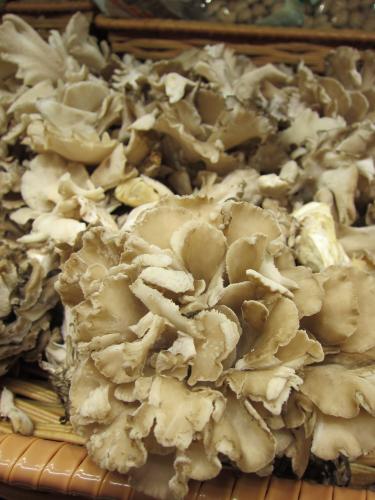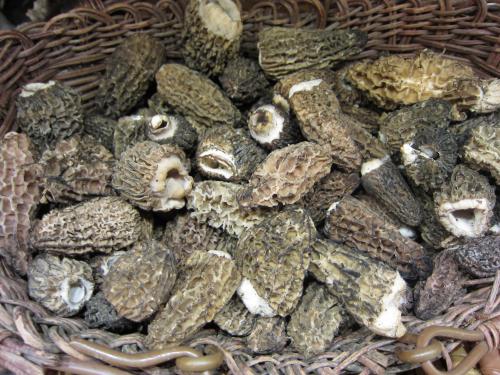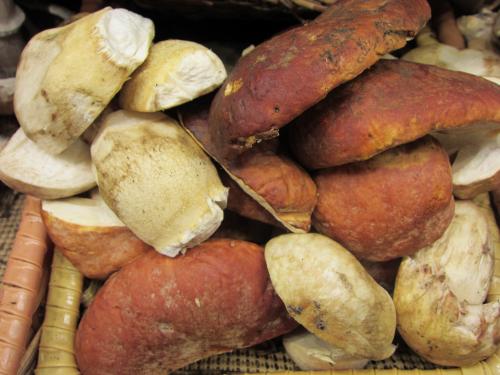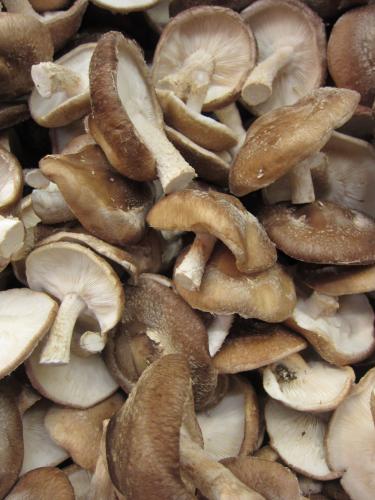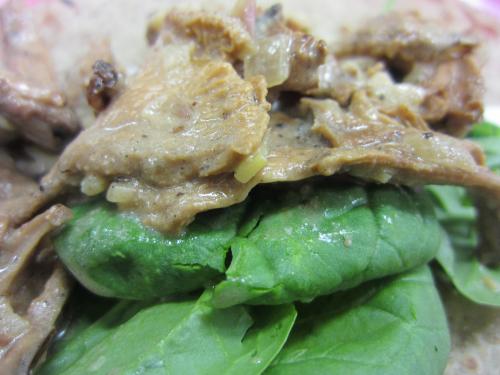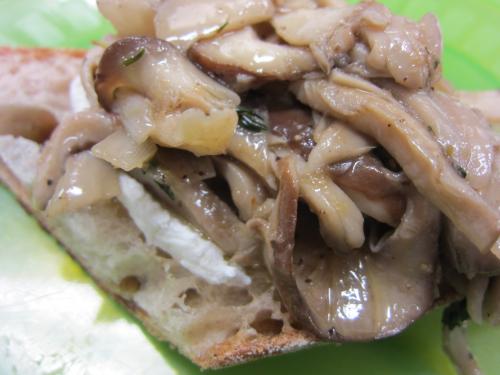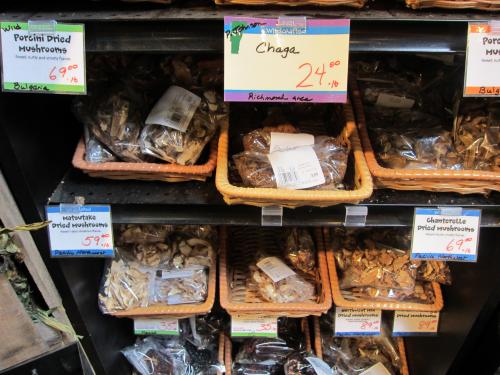Mushrooms, Foraged and Farmed
Mushrooms are an interesting example of a food that exists in that murky gray area between wild and cultivated, between poisonous and healthful, between life and death and seems to embody so much of traditional foods wisdom.
Maitakes, aka Hen of the Wood (cultivated)
When I think of our ancestors plucking these damp, fruiting bodies from their underground network of mycelium and learning which ones to eat and which ones to avoid, which ones to brew for tea and tinctures and which ones to eat as food, they seem to represent the original food around which culture is built, more so than bread. If wheat is agriculture, mushrooms are forest, and they play a fascinating role in their native environment.
Morels (wildcrafted)
Porcini (wildcrafted)
Mushroomsi have symbiotic relationships with many plants and trees: They absorb food and nutrients from their surroundings, similar to bacteria, by secreting digestive enzymes into their environment and absorbing what’s left over. In this way, they help decompose and recycle dead matter from trees and animals. However, they also help living plants and trees thrive by wrapping their thin mycelia around plant roots and giving up some nutrients in exchange for absorbing others, like a sponge – which is more or less what they feel like in your hand.
Some people are drawn to mushrooms and love the many arcane names and bits of trivia that go along with them. Others avoid them for the same reason – they seem confusing and mysterious, especially these days when mushrooms are undergoing a renaissance with wild foods in general and many unfamiliar varieties – unfamiliar to most of us, that is, but not our forbearers – are appearing in Produce department like City Market’s.
Shitakes (locally grown)
We source our fresh and dried mushrooms come from a variety of sources, such as local wildcrafters, from local growers like Amir Hebab of AH Mushrooms in Colchester (who grows wonderful shitakes and morels), from Pennsylvania-based Mother Earth Organic Mushrooms, and from Mycological Natural Products, a company based in Oregon that sends us beautiful wildcrafted fresh and dried mushrooms.
Recently, two members of our Produce department, Kara Brown and Jason Pappas, helped demystify wild mushrooms by showing two easy, versatile recipes for using wild mushrooms and one recipe for mushroom tea.
As luck would have it, the delivery of fresh, wildcrafted mushrooms from Oregon was held up in transit, so we got a real-life lesson in substituting certain wild mushrooms for others.
Tips for cooking fresh mushrooms:
- Minimally wash fresh mushrooms, cutting off the base as necessary to remove dirt. If you like, use a mushroom brush or soft-bristled toothbrush to remove any dirt that may be clinging to the surface.
- If you do need to wash them, stir them around in a dry, hot skillet for a few minutes to steam off excess water before proceeding with recipe.
- Consider making mushrooms the centerpiece of the meal: special wild and cultivated mushrooms have rich, earthy, meaty flavors that shine in sauces, sautés, soups, and stir fries.
Tips for cooking with dried mushrooms:
- Pre-soak dried mushroom in hot water for at least 30 minutes before cooking with them.
- Dried mushrooms have intense, concentrated flavor that works well in gravies, soups, and stews.
- Brew chaga, a special anti-oxidant rich mushroom, into dark, coffee-like brew for 30 minutes to several hours – drink as you would coffee or tea, with honey/milk/cinnamon to taste.
Wild Mushrooms with Goat Cheese and Spinach in Buckwheat Crepes
We used dried chanterelles for this recipe...
For the crepes:
3 eggs
1 cup milk
¼ cup + 2 Tbs. all-purpose flour
¼ cup + 2 Tbs. buckwheat flour
Pinch salt
Butter for frying crepes
For the filling:
2 oz dried mushrooms of choice (such as chanterelles or black trumpets)
2-3 Tbs. olive oil or butter
2-3 cloves garlic, minced
2 shallots, sliced
1 Tbs. white wine vinegar
1 Tbs. nutritional yeast
Salt and pepper to taste
***
3 Tbs. fresh dill
1 bunch fresh spinach, rinsed and drained
8 oz. fresh goat cheese
To make the crepes: Whisk eggs well in a medium mixing bowl. Add milk and whisk again. Add flours and salt and whisk well until no lumps remain. If time allows, let sit for up to 30 minutes so batter can “rest.”
Heat a heavy-bottomed frying pan over medium-high heat and add a knob of butter. Tilt pan so butter is distributed. Add a spoonful of crepe batter, or just enough so that it covers the bottom of the pan when you tilt it.
Cook about 2 minutes on the first side and 1 minute on the second side, or until slightly bubbly on top and golden on the bottom. Transfer to a plate. Repeat with remaining crepes. Makes about 10 6-inch crepes.
To make the filling: Wash the dried mushrooms and soak in a bowl of water for 20 minutes. Reserve liquid.
Heat olive oil/butter over medium heat and add garlic and shallots. Once the aromatics start sizzling, add the soaked mushrooms and stir. Add salt and pepper to taste.
Take the reserved liquid from the mushrooms (strain if needed) and add the vinegar. Bring the pan up to medium high heat, sprinkle on the nutritional yeast, stir in, and then add the cooking liquid, stirring frequently. After about a minute, take off the heat and let sit.
On your crepes, spread a thin layer of goat cheese, sprinkle the fresh dill, layer a few leaves of spinach, then finally add the mushroom filling. Roll up and enjoy!
Recipe from Kara Brown, Produce Department at City Market
Wild Mushrooms with Lemon & Thyme
We used fresh maitakes for this recipe...
1 Tbs. butter
1 Tbs. olive oil
1 medium shallot, thinly sliced
8 oz. assorted wild mushrooms (mix of porcinis, morels, and maiitakes, or as available)
2 garlic cloves, minced
1 Tbs. fresh thyme leaves
zest of one lemon
juice of one lemon
sea salt & freshly ground pepper
Heat the butter and olive oil in a large sauté pan set over medium-high heat until the butter starts to foam. Add the shallots and a generous pinch of sea salt. Cook, stirring often, until the shallots have softened a bit.
Lower the heat to medium. Add the mushrooms, garlic and thyme, and stir well until the mushrooms are evenly coated with the oil and butter. Continue cooking until the mushrooms begin to soften and release their juices, about 5-8 minutes depending on the mushroom size and type.
Add the lemon zest and juice. Add salt and pepper to taste. Continue cooking for another 1-2 minutes until the flavors are well combined.
Serve immediately. Try them over pasta, polenta or roasted root vegetables. A hearty, crusty bread also works well.
Recipe adapted from Eat Life Whole
Chaga Chai
You can find chaga in our dried mushroom section, a mushroom that grows on very few birch trees and is said to be as rich in supporting the immune system as it is rare to find. It makes a rich, earthy brew that some people like to drink instead of coffee or tea.
½ cup dried chaga
Local milk
Local honey
Cinnamon
Fill a small-medium pot with water and bring to a boil. Add chaga and allow to cook at a low boil for at least 30 minutes to several hours, or until you have a thick, dark brew. In each individual cup, add milk, honey, and cinnamon to taste.
Recipe rom Jason Pappas, Produce Department at City Market
